This form of psoriasis is a chronic inflammatory disease that mainly affects:
- Palms.
- Areas between the fingers.
- Hands.
Most often, people suffering from this form of the disease develop serious psychological complexes.
This form of the disease does not pose a serious threat to human life, however, with the development of severe forms, this disease can be accompanied by the development of a number of very serious complications.
One of the most common complications is damage to the joint area of the lower and upper extremities. This complication leads to the development of psoriatic arthritis. This disease is quite dangerous, because it can lead to the development of temporary and even disability.
Most people who suffer from psoriasis of the hands are diagnosed with lesions that appear especially on the palms and soles.
This form of the disease causes the patient many different inconveniences, because the main foci of the development of this disease cannot be hidden under clothing, and the formation of cracks is accompanied by the appearance of painful sensations.
The lesions themselves are small plaques, pink in color. Plaques strongly stand out above the surface of the skin and are eventually covered with gray scales.
In some cases, the formation of yellow pustules is observed.
The main symptoms of the development of this form of the disease:
- Dry skin.
- Thickening of the skin.
- Appearance of redness.
- The appearance of cracks.
- Appearance of callus-like formations.
Causes
Among the many factors that can cause the disease are:
- Allergic reactions;
- Diseases of the gastrointestinal tract;
- Diseases of the kidneys, liver and pancreas;
- Excess weight;
- Metabolism and endocrine system dysfunction;
- Hereditary predisposition;
- Chronic depression, stress or nervous tension.
As we have already mentioned, the exact causes of psoriasis have not yet been determined. Experts have not been able to determine exactly what causes psoriasis and in which cases it appears.
At the same time, diseases or moments that cause damage to the patient's skin have been identified:
- Heredity.
- Immune system disorders and metabolic problems.
- Psychoemotional overload.
- Bad habits and eating disorders.
- General intoxication.
- Viruses, bacteria, fungal infections.
- With a sharp change in the climatic conditions of life.
- In case of chronic skin disease.
- If the patient takes medicines of different pharmacological groups for a long time.
Sometimes the manifestation of the disease can appear if a person uses detergents that deprive the skin of its natural covering. It's important to remember that since psoriasis is not contagious, you don't need to be overly concerned about personal hygiene.
Various factors can cause hand eczema:
- hereditary predisposition;
- weakened immunity;
- endocrine gland disorders;
- changes in hormone levels;
- chronic diseases;
- infections;
- nervous tension;
- frequent stresses;
- constant exposure to chemicals (detergents, dyes, solvents) on the skin;
- uncontrolled use of drugs (for example, anti-inflammatory drugs);
- Clothing of synthetic fabrics;
- Rings and bracelets of certain alloys;
- cheap cosmetics of low quality;
- pollen;
- Poplar;
- animal hair;
- insect bites;
- mould;
- house dust;
- helminthic infestations;
- some food products.
The mechanism of psoriasis is not fully established, but it has been established that it is caused by a violation of the division of skin cells, whereby the affected cells begin to reproduce and grow 5-10 times faster. Soon immune cells join the process and blood vessels grow.
After the cells die, keratinized areas remain on the smooth surface of the skin - convex psoriatic plaques. In addition to genetic predisposition - characteristics of immunity, skin structure, indirect causes have been identified that influence the onset of psoriasis.
Recent medical research shows a connection between the disease and other pathologies:
- metabolic disorders (diabetes mellitus, hyperlipidemia, increased production of free radicals and nitrogen oxides involved in skin keratinization);
- atherosclerosis;
- cardiovascular diseases;
- liver and kidney pathologies;
- osteoporosis;
- obesity.
Risk factors include the following:
- smoking;
- alcohol abuse;
- change in weather conditions.
You cannot get infected by contact with a sick person, there are no external carriers of the disease. An inflammatory process occurs in the body, and a genetic predisposition to the characteristic disease cannot be ruled out. Other causes of hand psoriasis are detailed below:
- disturbed metabolism;
- hormonal imbalance;
- occupational hazard;
- tendency to allergic reactions;
- the presence of bad habits;
- poor nutrition;
- immune disorders of the body;
- violation of personal hygiene rules.
Dermatosis is heterogeneous. There are exogenous and endogenous drivers of the disease.
Exogenous factors include environmental temperature fluctuations, bad habits, prolonged drug use, infections, injuries, and an atherogenic nutritional profile. Endogenous factors are hereditary predisposition, weakened immunity, stress and sensitization of the organism.
Provocative factors trigger the development of the pathological process. Modern dermatologists usually consider psoriasis of the palms and soles to be the result of a combination of several triggers.
The causes of the disease are not fully understood. Scientists identify several theories:
- Psoriasis is a genetic disease.
- Psoriasis occurs due to disorders of the immune, endocrine and nervous systems.
- Psoriasis is a disease that occurs due to bad ecology and the accumulation of harmful substances in the body.
When these reasons come together, psoriasis appears. However, the main factor is still genetic: scientists have identified several genes that are responsible for the onset of the disease.
Factors that cause psoriasis:
- stressful situations;
- hazardous industries, especially those with high phenol concentrations;
- injuries, scratches, burns: sometimes psoriasis appears in these places;
- alcohol, smoking;
- infections: especially streptococci;
- improper selection of certain drugs.
Why does palm psoriasis develop?
Psoriasis can appear in a person regardless of age and gender. However, there are statistical data that indicate the frequent development of the disease between the ages of 30 and 50.
Scientists have determined that the main reason for the development of the disease is the dysfunction of the human immune system and genetic predisposition. However, these facts have not been fully proven and to date the clear causes of psoriasis remain unclear. The main factors that provoke palmar psoriasis include the following reasons:
- Reduced immunity.
- Mechanical damage to the palms.
- Frequent hand contact with water.
- Contact of the skin of the hands with chemicals, for example, household chemicals, as well as various products at work.
- They are often the cause of diseases such as scarlet fever, chronic tonsillitis, kidney disease and other diseases.
- Oncology.
Doctors attribute the abuse of alcohol, drugs and certain medications as another cause of the disease.
The main manifestations of palm psoriasis
It is worth noting that this type of disease occurs mainly in people who engage in physical work associated with stress on the hands. In medical practice, it is customary to distinguish between three types of diseases. This includes:
- Fan-shaped plaque.
- Circular.
- Calloused.
Types of psoriasis on the hands
| Localization of psoriasis on the hands | Description of the problem |
| On the palms | Redness of the surface of the skin of the palms, itching, roughness of the upper layer, appearance of blisters. From the outside, many people confuse palmar psoriasis with mycosis or eczema. In order to make a correct diagnosis, it is necessary to consult a specialist. |
| On hands and fingers | Inflammation, swelling of the fingers, peeling, cracking of the skin, pain and itching. |
Depending on the localization of the process and the specific location of the appearance of primary lesions, there are several types of hand psoriasis:
- Pustular - the most dangerous type, affects any skin. First, small spots appear on the phalanges of the fingers and palms that affect the nail plates. Then the spots merge, fill with pus, the lesion spreads to the hands and other areas, causing swelling and degenerative changes in the organs.
- Droplet - rashes are pale pink, convex, in the form of small drops. It is localized on the shoulders and forearms, grows and covers a wide area.
- Nails – This type of psoriasis causes changes in the appearance of the fingernails and toenails. The "thimble symptom" is observed when the color of the nail plates changes and small depressions and grooves form on them. At the same time, the nails thicken and begin to peel, until they are completely lost.
- Plak (Vulgarni) – in first place by frequency. These are typical psoriatic plaques with a tendency to coalesce and form "paraffin lakes". They appear above the elbow joints, on the extensor surface of the hands and affect the palms. Palmar psoriasis is characterized by roughness of the epidermis and the formation of bursting callus-like tubercles on the surface of the dermis.
Stages of the disease
In the initial stage of psoriasis on the hands, even before the appearance of the first rash, the following disorders can be recognized:
- swelling was observed in the joint area;
- the skin acquires a reddish hue in places;
- the nail plates become inflamed.
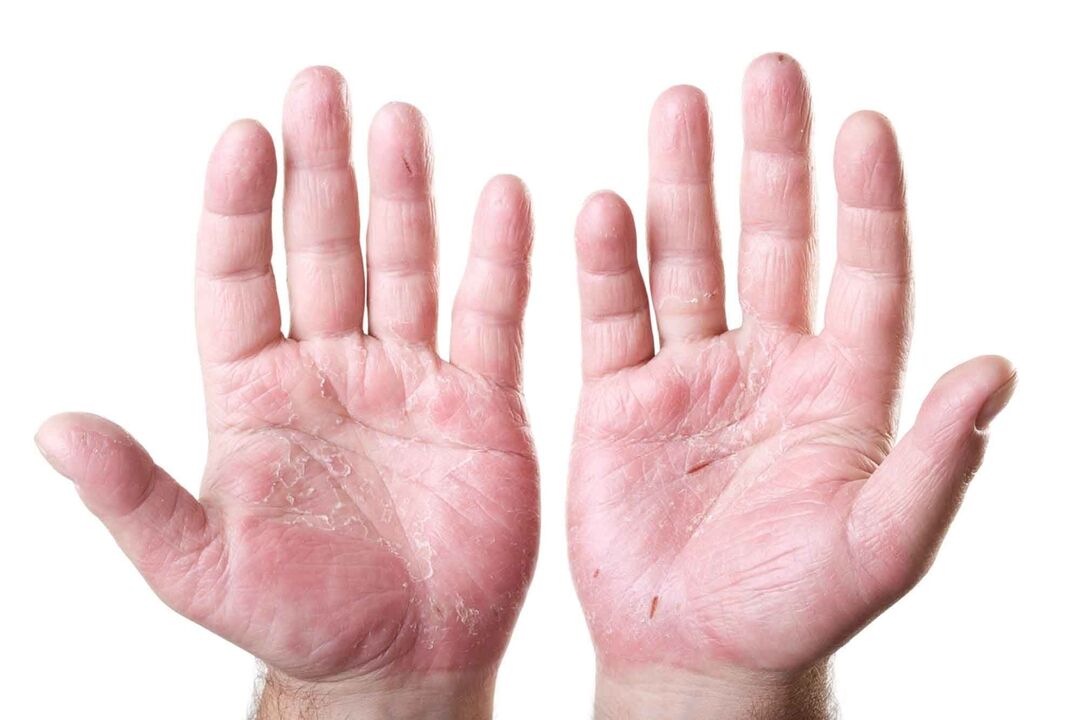
The following stages of psoriasis on the hands are different:
- Exacerbation is a progressive stage of the disease. It is characterized by an increase in the number and size of spots, increased itching and flaking.
- Stationary stage - it is characterized by a weakening of the disease, a change in the color of psoriatic plaques (they become less red, whiter), as well as a reduction in spots.
- The phase of remission is characterized by the complete disappearance of all signs of psoriasis.
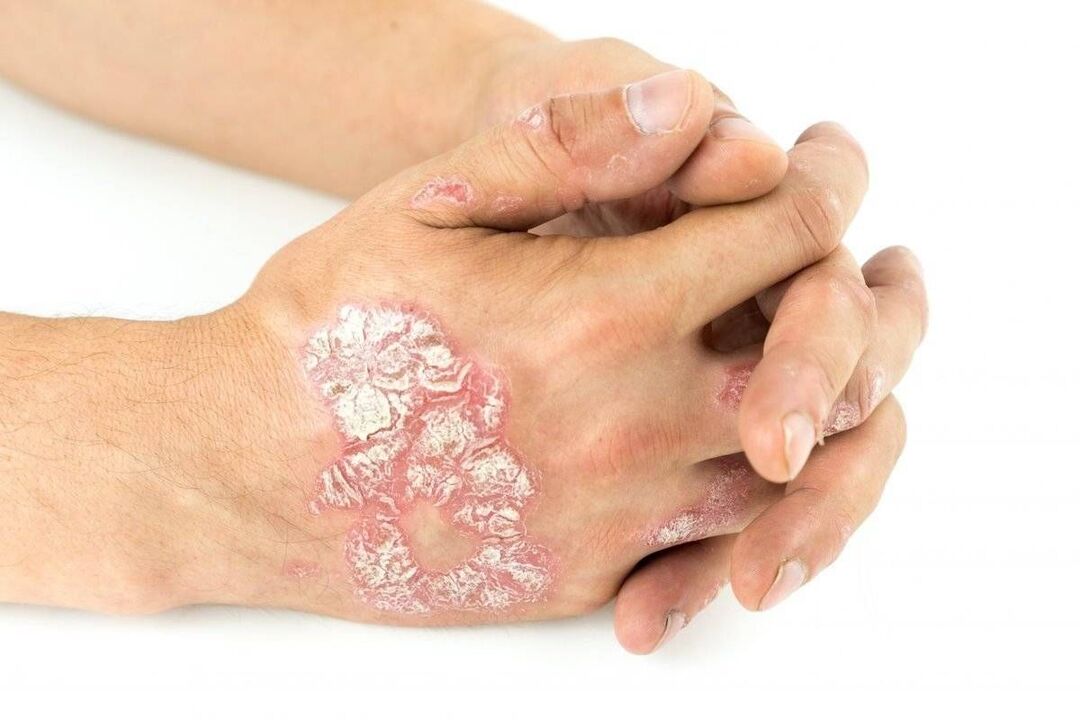
The sight of hands affected by psoriasis is extremely unpleasant. But the disease is so common that people need to know what psoriasis on the hands looks like in order to detect the problem in time and start treatment of the disease in time.
Psoriasis of the hands develops gradually. Doctors note that in medicine there are several stages of the disease, which are imperceptibly replaced in the absence of timely therapy. The clinical outcome for the patient depends entirely on the therapeutic measures of timely response. The development and signs of the different stages of psoriasis of the upper extremities are as follows:
- Initial phase. Small round papules have clear borders. At first, they are single, but 2-3 days after the peeling of the dermis, they spread and cover large areas of the lesion.
- Progressive phase. The painful nodules are characterized by a bright red shade, and in the center there is peeling of the epidermis with the formation of a crust. Pathology is preceded by microtrauma of the skin.
- Stationary stage. Sometimes red rashes turn bluish and dry. The inflammatory process reduces its intensity, itching stops, but hyperemia of the skin is present.
- Regressive stage. Local manifestations of psoriasis decrease in intensity, and when painful lesions recede. There is a long period of remission, there is no peeling, but white spots with clear borders are visible.
Psoriasis of any form and localization, including psoriasis of the skin of the hands, goes through 3 stages:
- Progressive phase (exacerbation) - spots grow, new ones appear, psoriasis manifestations intensify.
- Stationary stage - the manifestations of the disease fade, the spots fade and decrease in size.
- Regressive phase (remission) - manifestations completely disappear.
The initial stage of psoriasis on the hands and arms can manifest itself in different ways: either pale spots appear, barely noticeable, or immediately bright, as in the acute phase (less often).
Characteristics of therapy in pregnant women and children
Due to the weakened immunity of the mother and the immature immune system of the child, the treatment of eczema on the fingers requires:
- Adjusting the diet of the nursing mother and the child, limiting the intake of milk, consumption of green fruits and vegetables and fermented milk products. At an older age, it is necessary to exclude flour products, dried meat and foods rich in salt from the children's menu.
- Taking vitamin complexes to support the pregnant woman's immune system.
- One of the recommended measures is limiting contact with household chemicals and water.
- Use of antihistamine ointments or dermatotropic agents.
The following drugs can be prescribed for the treatment of children:
- Making lotions based on boric acid
- Taking calcium-based drugs, taking into account the reduced content of this microelement, characteristic of this pathology in children.
- To alleviate the symptoms of a severe infection, the use of ointments containing antibiotics is practiced.
- Use of antihistamines to reduce the intensity of itching.
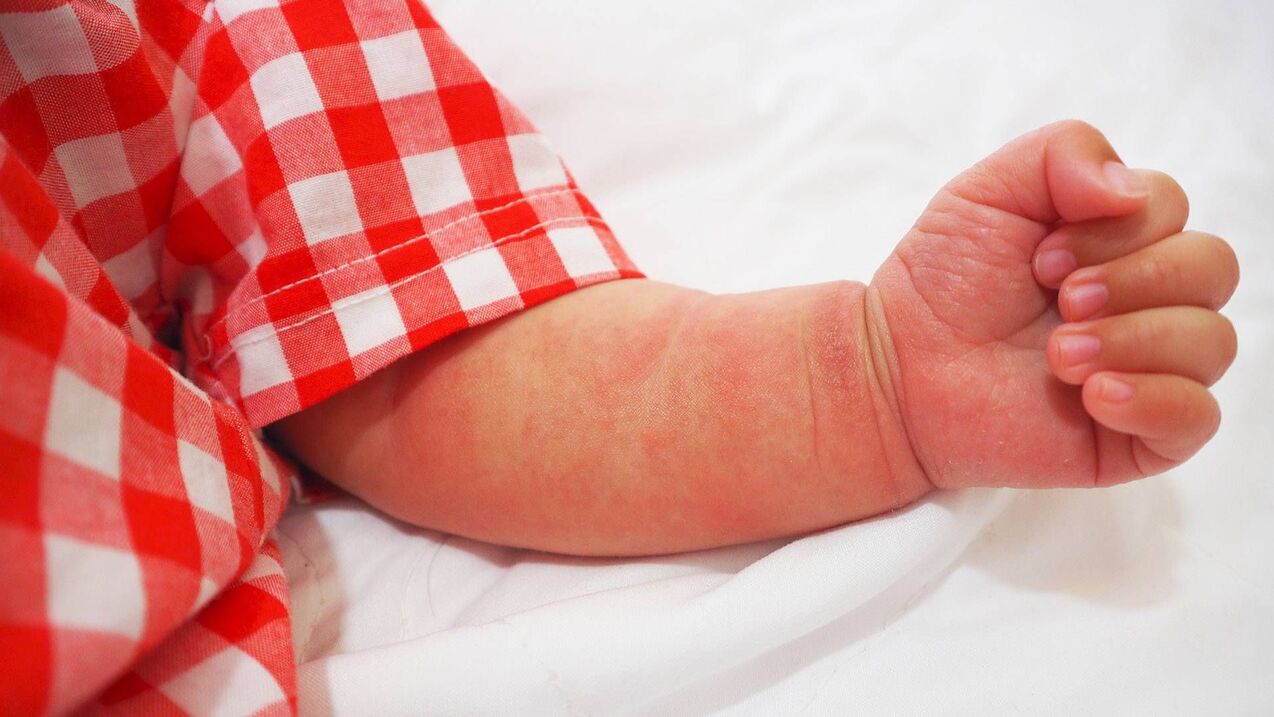
A set of measures aimed at the recovery of the mother and child should include compliance with personal hygiene standards and maintaining the sanitary condition of the premises.
Psoriasis on hands
Official medicine classifies hand psoriasis as a chronic disease of multifactorial etiology. This means that the exact causes of the disease have not been determined and doctors consider them as possible factors. Doctors classify it as a skin disease based on its main symptoms - red scaly plaques that appear on the skin. But the culprit of the disease is hidden deep in the human body.
During long studies on the mechanism of psoriasis development, scientists have identified a link with autoimmune failure.
The first signs of psoriasis appear on the hands in the form of small red papules with clear contours. 2-3 days pass and the papules are covered with scales. Then begins the long process of disease progression, marked by periods of exacerbation and remission. Thus, psoriasis that initially appears between the fingers can spread to the entire surface of the palm. Individual plaques grow and fuse, forming a continuous scaly crust. The photo clearly shows what psoriasis looks like on your hands.
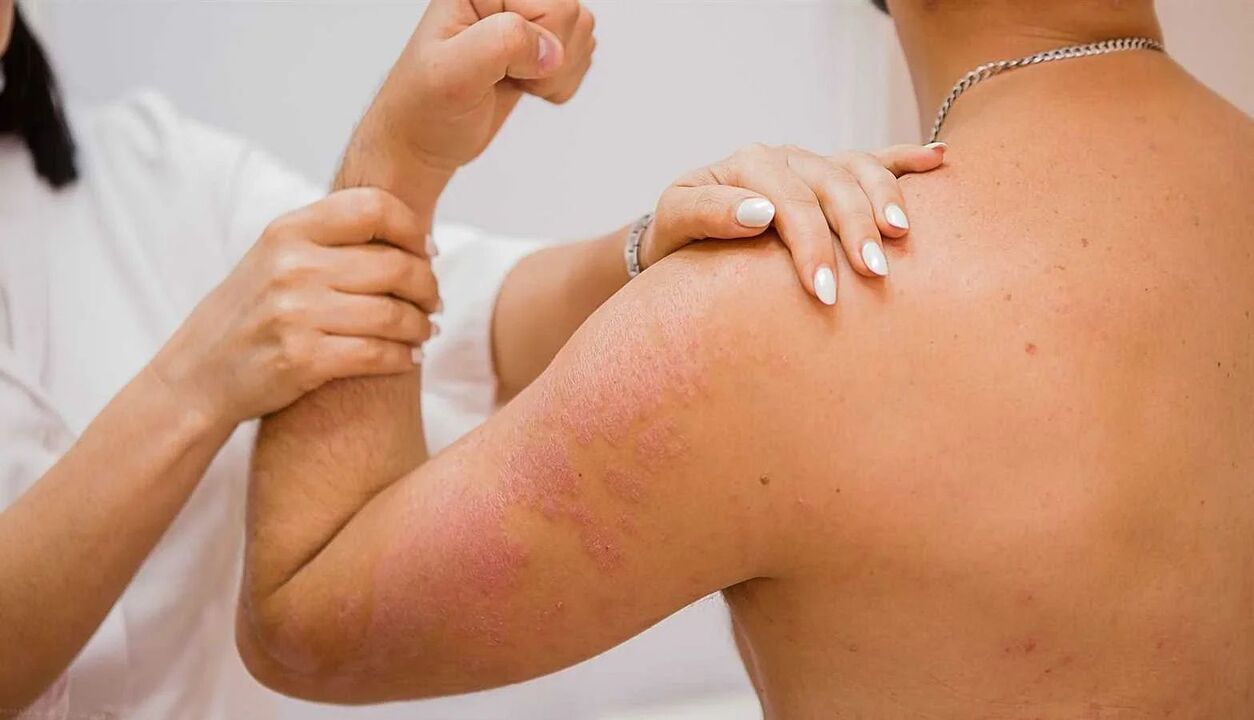
The first changes form on the back of the hand, gradually affecting the sides of the hand. Imperceptibly at the beginning of the negative process, they lead to an obvious cosmetic defect, when it is already difficult for a person to hide the presence of the disease. What could happen?
Symptoms of psoriasis on the hands
Symptoms characteristic of psoriasis on the hands should be considered in the context of their manifestation on any part of the patient's body. When the lesion begins, small areas of the dermis are affected, but the process does not end there and over time the plaques can cover the entire hand. General symptoms look like this:
- appearance of small papules;
- scale formation;
- dryness and peeling of the skin of the hands;
- nail plates lose their natural color, their structure changes;
- signs of skin hyperemia;
- the skin on the affected area becomes red;
- joint pain occurs;
- feeling of internal discomfort.
We have given general signs of the disease, but experts divide them according to the stages of the disease.
What forms of the disease are there?
The versatility of the manifestations of psoriasis that doctors encountered forced them to describe different forms of the disease. Experts have combined the existing species into two main groups: pustular and non-pustular.
The pustular group includes the following forms of the disease:
- generalized;
- similar to ring centrifugal erythema;
- palmoplantar.
The non-pustular group includes:
- classic form of psoriasis with early or late onset;
- psoriatic erythroderma.
The presented classification does not include such types of diseases as seborrheic, exudative, napkin disease, atypical and drug-induced psoriasis.
Reasons for psoriasis on the hands
Among all places affected by the disease, the hands account for 85% of all diagnoses. Long-term observations of patients suffering from the unpleasant disease have led scientists to the conclusion that the causes of psoriasis on the hands depend on the patient's gender and age.
Psoriasis is extremely rare in blacks. A scientific explanation for this fact has not yet been obtained.
What causes hand psoriasis in women?
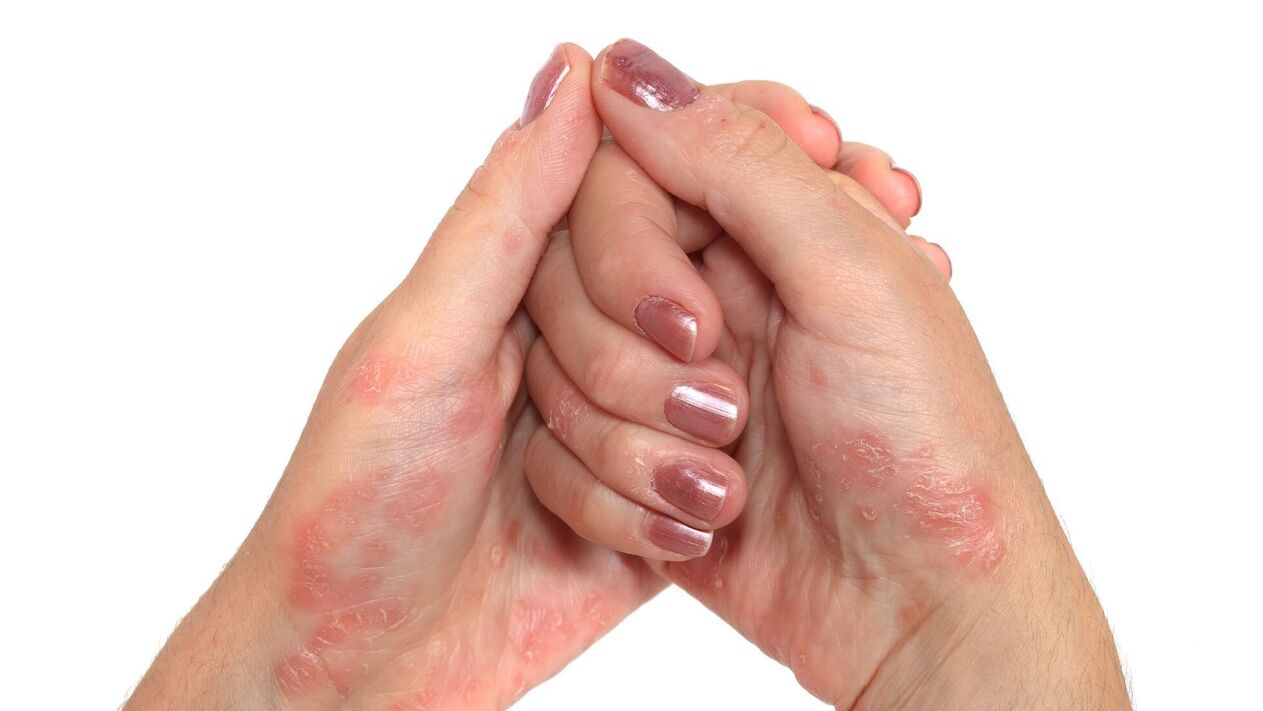
What doctors call genetic predisposition is the main reason. It is important to note that even if a woman's parents did not have psoriasis, it is likely that one of her relatives did. Other reasons include:
- climatic characteristics (very humid, cold or hot);
- hormonal imbalances;
- bad habits (alcohol, smoking, drugs);
- stress and nervous tension;
- taking antibiotics, some vaccines, overdosing on vitamin preparations;
- injuries, burns, cuts.
These same reasons can cause the disease to worsen. It is difficult to eliminate the mentioned factors from your life, but some of them can be eliminated.
What causes psoriasis on men's hands?
Trying to identify the main ones, doctors were forced to admit that they could not determine them with great precision. The basis for the development of psoriasis on men's hands is a malfunction of the immune system, which is expressed as:
- irregular metabolism;
- imbalance of lipid and carbohydrate metabolism;
- increased sugar level;
- cholesterol.
Those men who already have people in their family who have suffered from this disease are more likely to get psoriasis. The reasons can be:
- chronic lack of sleep;
- poor nutrition;
- cold climate.
Those who moved from the southern country to the northern region say that the cold climate causes the disease to worsen and is difficult to treat.
Causes of psoriasis on hands in children
In recent years, cases of diagnosis have become more frequent. It often takes a generalized form, with plaques covering large parts of the body. The first thing that is determined as the cause of the disease is a hereditary factor. According to statistics, among parents with psoriasis, the child will inherit the disease in 50% of cases. In addition to genetics, the disease can also be caused by:
- children's infectious diseases (measles, ARVI, tonsillitis);
- stressful situations;
- strong fear, loss of a loved one;
- heatstroke;
- unbalanced diet;
- hypothermia of the body;
- tendency to allergies.
Disease diagnosis
It is enough for the doctor to know what psoriasis on the hands looks like in order to make an accurate diagnosis. No special studies are conducted to determine the disease. If the patient says that the plaques on his hands appear for a long time, then the doctor can prescribe additional tests. Their list includes:
- blood biochemistry;
- general blood test to determine the amount of ESR;
- testing for rheumatoid factor and the presence of specific proteins;
- a biopsy done to detect immature skin cells, clusters of Rete bodies, macrophages, and T-leukocytes.
How to treat psoriasis on the hands?
Treatment of psoriasis on the hands depends entirely on the stage of the disease. Although the disease cannot be cured, by applying an integrated approach to treatment, the symptoms become almost invisible, and the remission lasts quite a long time.
External resources
In the initial and middle stages of the disease, it is sufficient to use drugs for external use. These can be creams and ointments from different groups:
- Non-hormonal. As a rule, they do not cause side effects, and their action is mild and gentle.
- Hormonal.
These drugs are used when severe symptoms appear (persistent rashes, brittle nails) when other ointments do not help. They are prescribed only by a doctor, they can have strong side effects. The frequency and duration of application of external agents depends on the severity of the symptoms: 1-2 times a day for 10-20 days. A break is required after each course.
Systemic drugs
Tablets and injections are prescribed when external drugs are ineffective in the later stages of psoriasis on the hands:
- Tablets: antihistamine, anti-inflammatory. Medicines from the groups of cytostatics, monoclonal antibodies, immunosuppressants, immunomodulators, sedatives and vitamins are also used.
- Injections: antihistamines, hepatoprotectors, immunosuppressants, immunomodulators, hormones.
The form and type of medicine depend on the stage of the disease and the intensity of its manifestations. The use of systemic drugs is carried out only under the supervision of a doctor.
Physiotherapy and traditional methods
Psoriasis is a long-term disease with multiple symptoms. Therefore, treatment is always comprehensive. Alternative methods can also be used:
- Physiotherapy: phototherapy, bioresonance and PUVA therapy, cryotherapy, ozone therapy, ichthyotherapy.
- Folk remedies: birch tar, linseed or sea buckthorn oil, aloe, bay leaf, baking soda, sea salt, etc.
Their purpose and use should also be agreed with a dermatologist.
Use of herbs
Many medicinal plants have the following properties:
- anti-inflammatory;
- regenerating;
- antibacterial.
For the treatment of palm psoriasis, celandine, St. John's wort, horsetail, oregano, nettle and others are used. An infusion or decoction is prepared from the herbs. They are also used to add to the bathroom.
Soda treatment
One of the methods that alternative medicine offers to get rid of psoriasis on the palms is the treatment with ordinary baking soda. Its use has the following effects on the affected skin:
- cleaning;
- softening;
- removal of inflammatory processes;
- improvement of local blood circulation;
- eliminates peeling;
- relieves itching.
The recipe for preparing a solution for external use is quite simple: dilute a certain amount of the product in purified water. You should get a viscous mushy mixture. This product must be applied to the affected areas. No need to rinse.
Prevention: what rules must be followed
Psoriasis on the hands will be easier to cure if, if possible, the factors that cause it are eliminated or minimized. In this case, the treatment will be much more effective, and the progression of the disease will be stopped.
The exact therapy, even in the earliest stages, can only be prescribed by a specialist, so an examination is mandatory. As well as the use of all available methods and means: from ointments and creams to injections, tablets and physiotherapy. The doctor will prescribe the sequence and dosage, but we must not forget about prevention even in the regression phase. Hands should be treated with the utmost care: using protective creams and excluding aggressive household chemicals.























